Doing: wasting time before the train back to Cairo and hiding from the touts by sitting in a smelly Alexandria internet cafe.
Reading: The Inheritance of Loss by Kiran Desai – Man Booker Prize winner of 2006. I stole this copy from a hostel in Cairo, and laughingly it’s a pirated version someone bought in India. The pages are photocopied, with the print rubbing off on my fingers. However, it’s a really brilliant book, cynical and chaotic.
Currently …
Sitting in a net cafe in Alexandria. Technically the tour I joined four weeks ago in Syria ended last Friday, but I’d been hanging out with Bronny, Dr. Brett and Surly till yesterday, and it’s quite a shock being on my own again.
Anyway, it appears the Middle East is not flush with internet like Europe, and besides the fast pace of Tour Group Life didn’t really allow much time to jabber on as I do on this blog. So here goes …
Last I wrote was about Gallipoli. The tour I went with, TJ’s, included a guided trip to Assos and Troy, as well as lunch at TJ’s parent’s house in a small village nearby.
Eceabat and Cannakkale

Me and the Eceabat kangaroo.
The nearest town to the Gallipoli national park is Eceabat, a small little seaside town that has no claim to fame other than being the nearest town to the Gallipoli national park. Hence why there is a hotel called ‘Hotel Crowded House’, restaurants that serve meat pies, and roadside flower pots in the shape of kangaroos.
To head over to Troy and Assos, though, we had to go across the Dardanelles by ferry, to reach Cannakkale (Cha-nak-ka-lay), the nearest big city where most Gallipoli pilgrims end up staying (at Anzac House Hotel, mind you).

Captain Karen.
By the way, the ferry boat captain likes foreigners and will happily let you play captain. I didn’t want to honk the horn though.
Cannakkale has a different claim to faim, though: it’s also the gateway to Troy for a lot of tourists, which is pretty obvious when you see this sitting beside the coast:

The Plastic Horse of Troy.
If you don’t recognise this fellow, try thinking of Brad Pitt:

Brad Pitt’s in there somewhere.
Turns out Warner Bros donated this proud piece of plastic wood to the oh so proud Turkish, who are building a special hill top monument for it, so anyone sailing down the Dardanelles can see it. The Locals refer to the Trojan horse sitting at the Troy site (see below) as the Wooden Horse of Troy; this one is referred to as the Plastic Horse of Troy, as it’s more wood like than actual wood.
Anyway, there was some interesting bits of graffiti at the ferry side, and a smelly polluted ride across the Dardanelles.
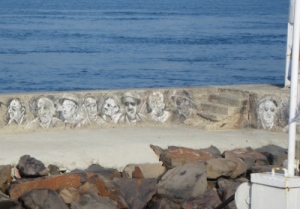
Graffiti.
Troy
Said Wooden Horse of Troy:

The Japanese Wooden Horse Trap at Troy.
Personally I thought the Trojan Horse at Troy was only slightly less tacky than the Big Lobster or the Big Rocking Horse back home, and that the Plastic Horse of Troy at Cannakkale looked more interesting, but I suppose they decided to keep this 70’s monstrosity because you can climb inside it:
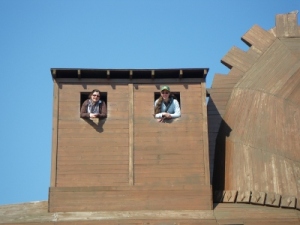
Me on the left, Leanne (Gallipoli buddy) on the right.

and other Gallipoli buddy Norm.
So, this site – known as Truva by the locals, but is also the ruin of the city of Illium – not far from Cannakkale is likely to be Homer’s Troy – or at least, more likely to be Homer’s Troy than the other sites scattered throughout the Aegean. The site has something like 7-9 layers of seperate cities and epochs, labeled by archeologists and historians as Troy I to Troy IX. Some fella back in the 1870s, Schliemann, went gangbusters excavating through the several centuries of layers of archeological ruins to reach those of the legendary city – which he believed was Troy II – only to find out later he’d gone too far, and actually destroyed most of the Troy VII level, thought to be Homeric Troy. Ouch.
Anyway, theres not much to see except random excavations and rubble; more interesting is the story of the archeologists and their mishaps (like Schliemann’s), and how they came to prove this is The Troy. There’s a Roman ampitheatre (of course: it’s not a Roman ruin without a Theatre), and a trench, some mud brick buildings with wasp and bee hives in them, and that’s pretty much it.
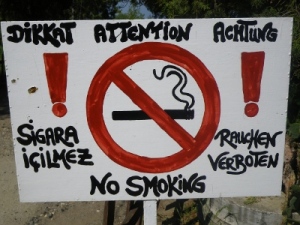
No Smoking!

Ruins.

Schliemann’s Stupid Man Trench

Altars from one of the later (Roman) settlements on the Truva site.
More amusing was our guide, who, truth be told, did a good job of providing a narrative to our visit. ‘I will tell you about Troy, the reality’ (grand gesture to the left), ‘and Troy, the dreeeaamm’ (grand gesture to the right). In his whispy, dramatic Turkish-accented voice, he told us plenty about the Illiad (the ‘dream’), and lots of fiddles about the ‘reality’. The Pyramid-shaped mountains in the distance? One’s the tomb of Achilles, the others of Paris and Petrocles. Alexander the Great apparently danced naked around the tomb of Achilles. As you do. And did you know the Trojans were such wonderfully civilised and advanced people?
‘I bet,’ said a unusually sarcastic Indian-American who’d joined our tour late, ‘he’ll tell us that all modern civilisation came from Turkey.’
Sure enough, next moment our guide was pointing out that London was once ‘New Troy’. ‘Next,’ the Indian guy muttered, ‘he’ll tell us the Turkish were the first to the moon.’
But hey, the day’s best treat was to come; lunch at TJ’s smiley parents house:
TJ’s village and insistent grannies

TJ and parents.
TJ apparently grew up in a small nomadic village not far from Eceabat, where he ended up living with an aunt in his early teens. Apparently nomadic Turks are settling down these days, but most of the villages don’t have running water, relying on traditional wells like these:
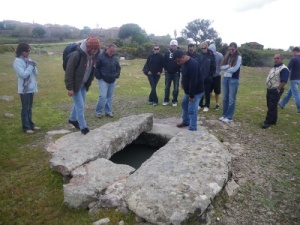
Traditional wells in TJ’s home village.
His village proudly has it’s own water and waste water plant, so these wells are now only used for livestock or other nomads travelling down the roads.
Dinner was great – my first gozleme (pancake/crepe with cheese and spinach, sometimes mince meat or tomato, an addiction that was long to be sated in other spots in Turkey). His parents were smiley happy people, who made fresh yoghurt for us, and served Coca-cola in bottles.

Gozleme, roast potato, rice, spring onion, yoghurt, and Coke. Traditional Turkish meal.
TJ took us out to a neighbouring nomadic Turk village, without running water (he pointed out the rubble latrines), rusty utes and farm animals in rubble wall enclosures. Out came running one seriously cute pre-teen girl, selling handwoven bags and wooden charms (“1 Lira!”), smiling sweetly and modestly hiding behind TJ. Five minutes later, the square was a marketplace, full of unfurled rugs, bags, crocheted scarfs and colourful village grannies grabbing at our arms and gleefully shoving their products in our faces:

Carpet, laid out.

Quick! Foreigners to sell stuff to!
The prices were awesome: hand made, natural wool and dyed carpets, large sizes around 200 lira (about 150-180 Australian). Small around 50 lira. I ended up buying a couple of wood charms from the cutie girl, and a crocheted scarf from one of the old ladies.
Another story: there was a white scarf, with wonderful embroidery on it, which I expressed interest in – 20 lira, fair price. It was a little dirty, though, and I was contemplating whether I wanted to get something that would need serious dry cleaning; with TJ translating, the lady explained it was old, ‘antique’ even, explaining why it was marked; it was a wedding scarf, designed for a hope chest or a dowry. Interesting I thought. Then it was said, ‘Oh it’s from her wedding’, TJ said of the old woman who was trying to sell me the scarf. Knowing full well that the lady would really prefer to have 20 lira than to holding onto a sentimental piece (and, who knows, she probably hated her husband and would be glad to get rid of the rag), I just couldn’t bring myself to buy something that had such significance, for such a price that seemed so insignificant. It did occur to me later that the ‘It’s from my wedding’ statement may have been a ruse to get me to buy it that backfired. Anyway, I’m pretty happy with the scarf I got, and later down the track I bought a lot of things from wizened old nomadic Turkish grannies, who insistantly, tapped, shouted, grinned, and hugged me to make me buy their stuff. I bought some Turkish granny dolls to give to friend’s daughters as a souvenir of their extreme nuttiness – they look just like their living counterparts.

Mind, poverty is relative.
Of course, just when you think you’re in a place as impoverished as it can get, never forget that they have satellite tv, and you don’t 😛
I doubt they’re paying Foxtel’s exhorbitant fees, anyway.
Assos
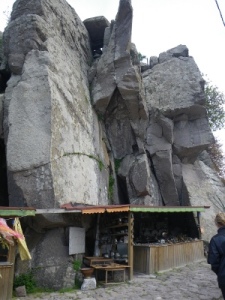
- Stalls outside Assos.
After the nomadic village, we went to Assos, an ancient greek ruin, with views across the Aegean to Lesvos Island (yes, that’s also known as Lesbos). It’s a tourist site that the foreign tourists rarely see – apparently the Turks swarm here at certain times of the year (we were outside the season, in April anyway). The Tout Gauntlet, a phenomenon which follows us everywhere throughout the middle east (where touts and shop merchants harrass you into buying their cheap trinkets), was relatively calm – especially since most of the stalls were closed. I did buy some socks from some more nomadic old ladies, considered the jewellery and contemplated more scarves (I was still undecided about whether it was the right choice to leave the white wedding scarf behind).
Assos is up really high, and there were some seriously magnificent views from up there. Otherwise, there’s not much of a reason to go there (as opposed to massive Graeco-Roman ruin sites like Efes and Palmyra), although the beautiful grey rock and the traditional village are interesting.

Panorama of the Assos site.

TJ demonstrates the best view.

View from Assos.

Cute lady at Assos.
Turkish ‘Culture’ Night
Okay, these nights are usually pretty lame, and avoided like the tourist plague, but this one was funny from several levels. There’s the belly dancer who was, admittedly, better than the other pitiful excuse we saw at the Orient Hostel in Istanbul, but a bit beyond her time (and clad in some serious sequins that would make Britney proud); paired with the hotel manager, Ramazan, who was getting into it a little too much. There were a series of teens from either a local dance troupe or a high school group, doing traditional performances; while the girls and most of the guys were more shy than outstanding, one of the boys was quite talented. However, the highlight was the food (some may complain about the over abundance of carbohydrates, but me being the carb-addict I am, loved every sticky-rice-potato-bread part of it); and a dear old man who played Waltzing Matilda on the accordion.

Mezze (appetizer plate).

Teenage dancers.

Nasty local liqueur.
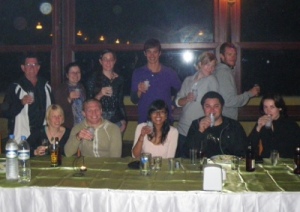
Nasty liqueur ahoy!
Can’t remember the name of the local Turkish liqueur: raki? It’s NASTY. Aniseed flavoured tequila, it may as well have been.
























































